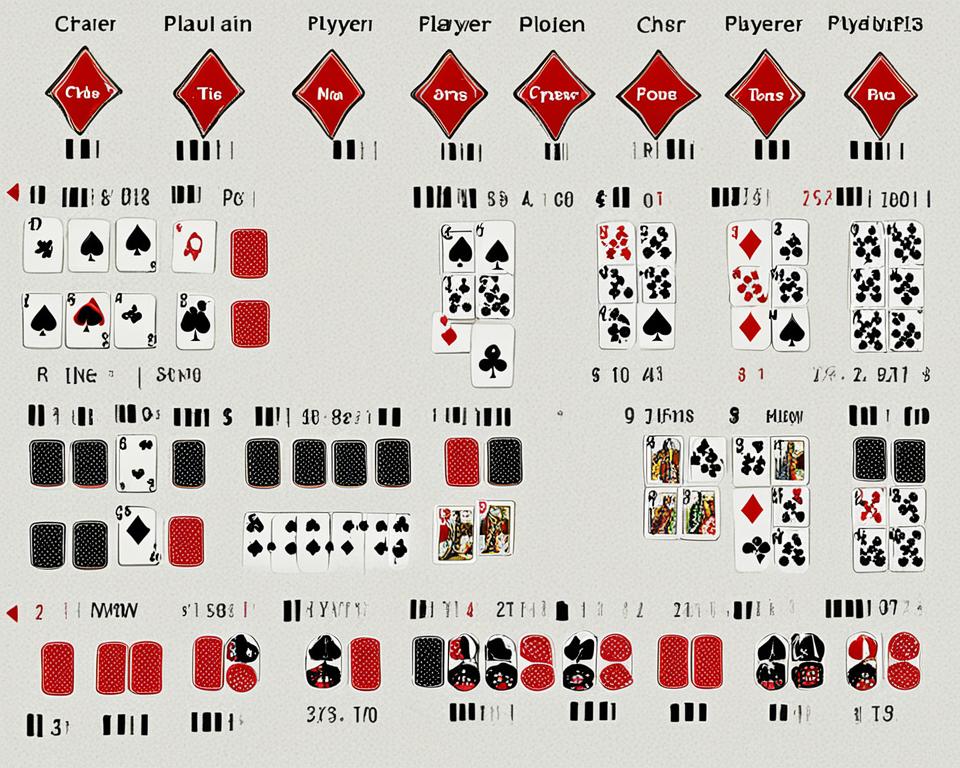If you’re a new player looking to improve your poker game, strategy charts can be an invaluable tool. These charts provide a visual representation of different aspects of the game, giving you a clear and concise reference to make better decisions at the table. Whether it’s understanding hand rankings, starting hands, blind names, player positions, or bet sizings, these charts cover it all.
By studying and utilizing these poker strategy charts, beginners can gain a deeper understanding of the game and improve their chances of success. With the help of these charts, you’ll be able to make smarter decisions, maximize your winning potential, and avoid costly mistakes. So let’s dive into the essential poker strategy charts for beginners!
Key Takeaways:
- Poker strategy charts provide concise and visual guidance for new players.
- These charts cover hand rankings, starting hands, blind names, player positions, and more.
- By studying and utilizing these charts, beginners can make better decisions at the poker table.
- Using strategy charts can help maximize winning potential and minimize costly mistakes.
- Improving your poker game with strategy charts takes practice and dedication.
Poker Winning Hands Chart: Hand Rankings
Understanding hand rankings is essential for any poker player. The poker winning hands chart provides a comprehensive list of hand rankings, from the highest-ranking hand, the Royal Flush, to the lowest-ranking hand, the High Card. Each hand is defined and examples are given. Familiarizing yourself with these rankings will help you make better decisions at the table and increase your chances of winning.
Here is a detailed breakdown of the hand rankings:
| Hand Ranking | Description |
|---|---|
| Royal Flush | The highest-ranking hand consisting of Ace, King, Queen, Jack, and Ten of the same suit. |
| Straight Flush | Any five cards of the same suit in consecutive order. |
| Four of a Kind | Four cards of the same rank. |
| Full House | A combination of three of a kind and a pair. |
| Flush | Any five cards of the same suit in no particular order. |
| Straight | Any five cards in consecutive order but not of the same suit. |
| Three of a Kind | Three cards of the same rank. |
| Two Pair | A combination of two pairs. |
| One Pair | Two cards of the same rank. |
| High Card | The absence of any of the above combinations. The highest card in the hand determines the rank. |
By referring to the poker winning hands chart, you can easily determine the strength of your hand and make informed decisions during gameplay. Take the time to study and memorize these hand rankings to improve your overall poker strategy.
Navigating the Hand Rankings:
In poker, the strength of your hand is determined by its ranking. The higher the hand ranking, the better your chances of winning the pot. Here’s an example to illustrate:
Let’s say you hold the following hand: Ace of Spades, King of Hearts, Queen of Diamonds, Jack of Clubs, and Ten of Spades. This hand, known as a Royal Flush, is the highest-ranking hand possible. It consists of the A, K, Q, J, and 10 of the same suit. Having a Royal Flush guarantees that you have the best possible hand at the table, making it highly likely that you will win the pot.
Knowing the hand rankings allows you to assess the strength of your hand and make strategic decisions based on the probabilities of winning. Understanding these rankings is a fundamental skill that every poker player should possess.
Poker Hands Chart: Top 10 Starting hands in Texas Hold’em
New players often struggle with which hands to play when starting a game of Texas Hold’em. To help ease that uncertainty, here is a chart showcasing the top 10 starting hands in Texas Hold’em. These hands are considered the cream of the crop, known for their potential to make the most money and secure victories at the poker table.
Below is a list of the top 10 starting hands:
| Rank | Starting Hand |
|---|---|
| 1 | Pocket Aces (Ace-Ace) |
| 2 | Pocket Kings (King-King) |
| 3 | Pocket Queens (Queen-Queen) |
| 4 | Ace-King Suited (AKs) |
| 5 | Pocket Jacks (Jack-Jack) |
| 6 | Ace-King Offsuit (AKo) |
| 7 | Pocket Tens (10-10) |
| 8 | Pocket Nines (9-9) |
| 9 | Ace-Queen Suited (AQs) |
| 10 | Ace-Jack Suited (AJs) |
These hands possess significant strength and should be played aggressively in most scenarios. However, it’s important to note that poker is a dynamic game, and situational factors can impact the optimal play. Players should remain flexible and adapt their strategy according to the specific circumstances at the table.
Remember, mastering the strategy behind these top starting hands can provide a solid foundation for success in Texas Hold’em. By using the poker hands chart and refining their skills through practice and experience, players can enhance their decision-making abilities and increase their chances of winning.
Poker Hands Chart: Common Starting Hand Nicknames
When it comes to poker, many players enjoy using nicknames to refer to specific starting hands. These nicknames add a touch of character and charm to the game, making it even more exciting and vibrant. If you’re new to poker, familiarizing yourself with these common starting hand nicknames can help you better understand the game and its community.
| Starting Hand | Nickname |
|---|---|
| Ace Ace | Bullets, Rockets |
| King King | Cowboys |
| Queen Queen | Ladies |
| Jack Jack | Fishhooks |
| Ace King | Big Slick |
| Ace Queen | Little Slick |
| Ace Jack | Blackjack |
| King Queen | Royal Couple |
| King Jack | Kojack |
| Queen Jack | Maverick |
Notable Starting Hand Nicknames
Here are a few notable starting hand nicknames worth mentioning:
- Bullets or Rockets: Refers to pocket Aces (Ace Ace). It’s the best starting hand in poker, often associated with immense strength and power.
- Cowboys: Nickname for pocket Kings (King King). This hand is second only to pocket Aces in its perceived strength.
- Big Slick: A combination of an Ace and a King (Ace King), often perceived as a strong hand due to its high card value.
These nicknames are just a glimpse into the colorful world of poker starting hand nicknames. Exploring more of them will not only help you learn the game but also immerse you in the rich history and tradition of poker.
Next, let’s delve into the nicknames given to common made hands in poker. This will expand your poker vocabulary and deepen your appreciation for the game.
Poker Hands Chart: Common Made Hand Nicknames
Just like starting hands, made hands in poker also have their own set of nicknames. These nicknames add flavor and personality to the game, making it more enjoyable for players. Here is a chart of some of the most common made hand nicknames:
| Made Hand | Nickname |
|---|---|
| Four of a Kind (Kings) | The Cowboys |
| Straight Flush (Ace-high) | Royal Flush |
| Full House (Aces over Kings) | Aces Full |
| Flush (King-high) | King’s County |
| Straight (Ten-high) | Ten to Ace |
| Three of a Kind (Queens) | Ladies |
These are just a few examples of the many nicknames given to made hands in poker. They vary from region to region and table to table, adding a touch of creativity and camaraderie to the game. Remember, the next time you hit a strong hand, you can impress your fellow players by referring to it with one of these common nicknames.
And now, let’s take a moment to appreciate a visual representation of these common-made hand nicknames:

Poker Blinds Chart: Names of Table Stakes
In the world of poker, understanding the names of table stakes is essential for players looking to navigate the various blind levels. This chart presents the names of table stakes for poker blinds at different levels, catering to both beginners and experienced players.
Whether you’re playing at the lowest stake levels or participating in high-stakes games, it’s crucial to be familiar with the terminology associated with table stakes. By knowing the names used for different blind levels, you can confidently enter games and adjust your strategies accordingly.
Take a look at the chart below to explore the hierarchy of table stakes:
| Blind Level | Stake Name |
|---|---|
| 2NL | Micro Stakes |
| 5NL | Micro Stakes |
| 10NL | Micro Stakes |
| 25NL | Low Stakes |
| 50NL | Low Stakes |
| 100NL | Low Stakes |
| 200NL | Mid Stakes |
| 500NL | Mid Stakes |
| 1000NL | High Stakes |
| 2000NL | High Stakes |
| 5000NL | High Stakes |
Now you can confidently navigate the poker landscape with a clear understanding of the names associated with different table stakes. Whether you’re playing micro stakes or high stakes, this knowledge will help you make informed decisions and adapt your strategy to each blind level.
Abbreviations for Player Positions at a Poker Table
Poker tables have designated positions to ensure fairness and order during gameplay. These positions are commonly referred to using abbreviations, which are essential to understand the dynamics of the game. Whether you’re playing a full ring (10-max) or a short-handed (6-max) game, knowing these abbreviations will help you stay on top of your poker strategy. Here is a breakdown of the player positions and their corresponding abbreviations:
Full Ring (10-Max) Game Positions
| Position | Abbreviation |
|---|---|
| Under the Gun | UTG |
| Under the Gun +1 | UTG+1 |
| Under the Gun +2 | UTG+2 |
| Early Position | EP |
| Middle Position | MP |
| Hijack | HJ |
| Cutoff | CO |
| Button | BTN |
| Small Blind | SB |
| Big Blind | BB |
Short-Handed (6-Max) Game Positions
| Position | Abbreviation |
|---|---|
| Under the Gun | UTG |
| Under the Gun +1 | UTG+1 |
| Early Position | EP |
| Cutoff | CO |
| Button | BTN |
| Small Blind | SB |
By learning these abbreviations, you can easily understand the flow of action at the poker table and make informed decisions based on the positions of other players. Incorporating this knowledge into your poker strategy will greatly enhance your chances of success.

Poker Starting Hand Ranges Chart (6-max Cash, 100bb): Hand Chart Notation
When playing a 6-max cash game with a 100bb stack size, it’s crucial to have a solid understanding of poker starting hand ranges. This chart provides a detailed notation of recommended starting hand ranges for each position at the table. By following these ranges, players can make more informed decisions and optimize their chances of success.
Here is the hand chart notation for 6-max cash games:
| Position | Hand Range |
|---|---|
| Under the Gun (UTG) | 22+, A2s+, KTs+, QJs, A4o+, KJo+ |
| Hijack (HJ) | 22+, A2s+, KTs+, QTs+, JTs, T9s, A5o+, KJo+, QJo |
| Cutoff (CO) | 22+, A2s+, KTs+, QTs+, JTs, T9s, A8o+, KJo+, QJo |
| Button (BTN) | 22+, A2s+, K2s+, Q2s+, J2s+, T2s+, 92s+, A2o+, K2o+, Q6o+, J8o+, T8o+ |
| Small Blind (SB) | 22+, A2s+, K2s+, Q2s+, J2s+, T2s+, 92s+, A2o+, K2o+, Q7o+, J8o+, T8o+, 98o |
| Big Blind (BB) | 22+, A2s+, K2s+, Q2s+, J2s+, T2s+, 92s+, A2o+, K2o+, Q7o+, J8o+, T8o+, 98o |
It’s important to note that these ranges are not set in stone and can be adjusted based on factors such as table dynamics and opponent tendencies. However, they serve as a solid foundation for new players looking to develop a disciplined and profitable poker strategy.
By utilizing this hand chart notation, players can gain a better understanding of the range of hands they should be playing from each position. This knowledge enables them to make more informed decisions and capitalize on favorable situations at the poker table. Whether you’re a novice player or an experienced pro, having a clear starting hand strategy is essential for long-term success in 6-max cash games.
Poker Starting Hand Ranges Chart (9-Max Cash, 100bb): Linear Notation
In a 9-max cash game with a 100bb stack size, it’s crucial to have a solid understanding of the optimal starting hand ranges for each position. This linear notation chart provides valuable insights into the recommended hands to play from each position, helping players make informed decisions and maximize their profits.
It’s important to note that these starting hand ranges are not fixed rules, but rather guidelines that can be adjusted based on the table dynamics, opponents’ tendencies, and other relevant factors. Adapting your strategy accordingly is key to achieving success in poker.
Linear Notation Chart:
| Position | Opening Range |
|---|---|
| Under the Gun | 22+, A2s+, K9s+, Q9s+, J9s+, T9s, 98s, 87s, 76s, ATo+, KJo+, QJo |
| Early Position | 22+, A2s+, K9s+, Q9s+, J9s+, T9s, 98s, 87s, ATo+, KJo+, QJo |
| Middle Position | 22+, A2s+, K8s+, Q8s+, J8s+, T8s+, 97s+, 86s+, 76s, A9o+, KTo+, QTo+, JTo |
| Cutoff | 22+, A2s+, K2s+, Q6s+, J7s+, T7s+, 97s+, 86s+, 75s+, 65s, A8o+, K9o+, QTo+, JTo |
| Button | 22+, A2s+, K2s+, Q2s+, J2s+, T2s+, 92s+, 83s+, 73s+, 63s+, 53s+, 43s, A2o+, K2o+, Q5o+, J7o+, T7o+, 97o+, 87o, 76o |
| Small Blind | 22+, A2s+, K2s+, Q2s+, J2s+, T2s+, 92s+, 83s+, 73s+, 63s+, 53s+, 43s, A2o+, K2o+, Q5o+, J7o+, T7o+, 97o+, 87o, 76o, 65o |
| Big Blind | 22+, A2s+, K2s+, Q2s+, J2s+, T2s+, 92s+, 83s+, 73s+, 63s+, 53s+, 43s, A2o+, K2o+, Q2o+, J4o+, T5o+, 95o+, 85o+, 75o+ |
It’s important to remember that the above ranges are just starting points and can be adapted based on your own playing style and the specific dynamics of your table. As you gain experience and develop a deeper understanding of your opponents, you can refine and adjust your ranges accordingly.
Poker Pot Odds Chart (Relating to Bet Sizings Used)
In the world of poker, understanding pot odds is crucial for making informed decisions at the table. A pot odds chart helps players determine the profitability of their potential bets based on the size of the pot and the amount they need to call. By using this chart, players can strategically size their bets to maximize their chances of winning.
Calculating pot odds involves comparing the size of the current pot to the cost of a contemplated call. This allows players to determine whether the potential payout justifies the investment. The chart provides a formula that players can use to calculate their required equities to make profitable calls in different bet sizing scenarios. It also highlights value-to-bluff ratios, enabling players to understand the balance between strong hands and well-timed bluffs.
Poker bet sizing is an essential component of any successful betting strategy. By using the pot odds chart, players can make more informed decisions on when to bet, raise, call, or fold. It helps players align their bets with their hand strength and the potential value of the pot, increasing their chances of winning in the long run.
Next, we will explore another important aspect of poker strategy with the poker odds chart, which focuses on calculating outs and equities for different hands.
Poker Odds Chart: Outs and Equities (Poker Equity Chart)
Understanding the odds and equities in poker is crucial for making informed decisions at the table. The poker odds chart, also known as the poker equity chart, provides players with valuable insights into their chances of improving their hand and winning the pot.
An important concept in poker is the idea of “outs.” Outs are the number of cards remaining in the deck that can improve a player’s hand to a desirable outcome, such as making a straight or a flush. The more outs a player has, the higher their chances of improving their hand. The poker odds chart showcases the percentage likelihood of hitting these desired outcomes based on the number of outs.
For example, let’s say a player has a flush draw after the flop, meaning they have four cards of the same suit and need one more to complete their flush. The poker odds chart can provide them with an estimate of their chances of hitting that flush based on the number of outs they have. This information is invaluable when deciding whether to continue betting or folding.
The poker equity chart takes the concept of outs one step further by considering the potential equities of different hands. Equities represent a player’s share of the pot’s total value based on their chances of winning the hand. By using the poker equity chart, players can assess the profitability of their hands and make better-informed decisions about their betting strategies.
As shown in the poker equity chart, the equities for specific outs vary depending on the number of remaining players in the hand. It’s important to note that equities are not fixed values but rather probabilities that can change throughout the course of a hand.
Tips for Using the Poker Odds Chart and Poker Equity Chart
- Study the chart: Take the time to familiarize yourself with the poker odds chart and the poker equity chart. Understanding the percentages and probabilities associated with different outs and equities will help you make more strategic decisions.
- Consider position: Remember that your position at the table can influence your decision-making. The poker odds chart and equity chart are most effective when used in conjunction with an understanding of player positions and betting patterns.
- Adjust for opponents: Keep in mind that the poker odds chart and equity chart provide general guidelines. They do not account for the playing styles and skill levels of your opponents. Consider their tendencies and adjust your decisions accordingly.
By leveraging the insights provided by the poker odds chart and poker equity chart, you can gain an edge over your opponents and improve your overall poker strategy. These tools are particularly helpful when making difficult decisions, such as weighing the potential risks and rewards of drawing to a specific hand.
Remember, poker is a game of skill and probability. Utilizing the poker odds chart and poker equity chart can give you a better understanding of the odds and equities involved in various poker hands, enabling you to make more informed decisions and increase your chances of success at the table.
Conclusion
In conclusion, these essential poker strategy charts serve as a valuable resource for beginners aiming to enhance their gameplay. By familiarizing themselves with these charts, players can develop a solid foundation in poker strategy that will assist them in making more informed decisions at the poker table.
These beginner-friendly poker strategy charts cover a broad range of topics, including hand rankings, starting hands, blind names, player positions, and more. Each chart provides useful information and examples to help players understand the concepts and apply them in their gameplay.
Utilizing these charts allows players to identify the strengths and weaknesses of different hands, enabling them to adjust their play accordingly. It provides a systematic approach to poker strategy, which can significantly improve a beginner’s chances of success.
By studying and utilizing these essential poker strategy charts, beginners can gain confidence in their decision-making abilities and refine their gameplay. With practice and experience, they can progress from relying solely on the charts to developing their own strategic instincts, ultimately becoming more skilled and effective poker players.
FAQ
What is a poker winning hands chart?
A poker winning hands chart is a comprehensive list of hand rankings in poker. It starts with the highest-ranking hand, the Royal Flush, and goes down to the lowest-ranking hand, the High Card. It provides players with a clear understanding of the hierarchy of hands in the game.
What are the top 10 starting hands in Texas Hold’em?
The top 10 starting hands in Texas Hold’em are a set of strong starting hands that have the potential to make the most money in the game. These hands include pocket aces (Ace-Ace), pocket kings (King-King), and other premium hands that new players are recommended to play.
What are the common nicknames for different starting hands in poker?
Common nicknames are often given to different starting hands in poker. For example, pocket aces (Ace-Ace) are frequently referred to as “bullets” or “rockets.” These nicknames add a fun and memorable element to the game.
Are there any nicknames for different made hands in poker?
Yes, there are nicknames for different made hands in poker. For instance, a straight flush can sometimes be called a “steel wheel” and four kings can be referred to as the “four horsemen.” These nicknames add an extra layer of excitement to the game.
What are the names of table stakes for poker blinds at different levels?
The names of table stakes for poker blinds vary depending on the level of the game. The chart provides a comprehensive list of these names, ranging from the lowest stake (2NL) to the highest stake (5000NL).
What abbreviations are used for player positions at a poker table?
Player positions at a poker table have common abbreviations. The chart explains these abbreviations for both full ring (10-max) and short-handed (6-max) games, making it easier for players to understand and discuss their positions during gameplay.
What is the notation for starting hand ranges in 6-max cash games?
The chart provides a detailed notation of starting hand ranges for 6-max cash games with a 100bb stack size. This notation helps players determine which hands to play from each position on the table and makes their decision-making process more informed.
How can I determine the starting hand ranges in 9-max cash games?
The chart provides a linear notation of starting hand ranges for 9-max cash games with a 100bb stack size. This allows players to understand which hands to play from each position on the table, enabling them to make better decisions during gameplay.
How can I calculate pot odds based on different bet sizings?
The chart helps players calculate pot odds based on different bet sizings. It provides a formula that allows players to determine the required equities to be profitable and the value-to-bluff ratios needed to make strategic betting decisions.
How can I determine my chances of improving a hand based on the number of outs?
The chart shows the percentage chances of improving a hand to a specific outcome, such as making a straight or flush, based on the number of outs. This information helps players assess their odds of winning a hand and make more informed decisions at the poker table.
How can poker strategy charts help beginners?
Poker strategy charts provide valuable guidance for beginners looking to improve their game. By studying and utilizing these charts, beginners can make smarter decisions at the poker table, increase their chances of success, and develop a solid foundation in poker strategy.





